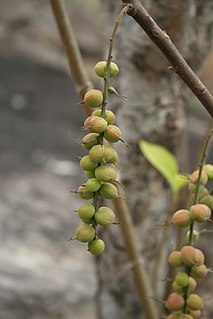
Parabens are a class of widely used preservatives in cosmetic and pharmaceutical products. Chemically, they are a series of parahydroxybenzoates or esters of parahydroxybenzoic acid. Parabens are effective preservatives in many types of formulas. These compounds, and their salts, are used primarily for their bactericidal and fungicidal properties. They are found in shampoos, commercial moisturizers, shaving gels, personal lubricants, topical/parenteral pharmaceuticals, suntan products, makeup, and toothpaste. They are also used as food preservatives.
The Kolbe–Schmitt reaction or Kolbe process is a carboxylation chemical reaction that proceeds by heating sodium phenoxide with carbon dioxide under pressure, then treating the product with sulfuric acid. The final product is an aromatic hydroxy acid which is also known as salicylic acid.

Ethylparaben (ethyl para-hydroxybenzoate) is the ethyl ester of p-hydroxybenzoic acid. Its formula is HO-C6H4-CO-O-CH2CH3. It is a member of the class of compounds known as parabens.

Propylparaben, the n-propyl ester of p-hydroxybenzoic acid, occurs as a natural substance found in many plants and some insects, although it is manufactured synthetically for use in cosmetics, pharmaceuticals, and foods. It is a member of the class of parabens. It is a preservative typically found in many water-based cosmetics, such as creams, lotions, shampoos, and bath products. As a food additive, it has the E number E216.

Açaí oil is obtained from the fruit of Euterpe oleracea, which grows in the Amazon rainforest. The oil is rich in phenolic compounds similar in profile to the pulp itself, such as vanillic acid, syringic acid, p-hydroxybenzoic acid, protocatechuic acid and ferulic acid as well as (+)-catechin and numerous procyanidin oligomers.
Monohydroxybenzoic acid may refer to any of three isomeric phenolic acids:

Heptylparaben (heptyl p-hydroxybenzoate) is a compound with formula C7H15(C6H4OHCOO). It is a paraben which is the heptyl ester of p-hydroxybenzoic acid.
In enzymology, a gallate decarboxylase (EC 4.1.1.59) is an enzyme that catalyzes the chemical reaction
In enzymology, a gentisate decarboxylase (EC 4.1.1.62) is an enzyme that catalyzes the chemical reaction
In enzymology, a protocatechuate decarboxylase (EC 4.1.1.63) is an enzyme that catalyzes the chemical reaction

Alchornea cordifolia is a shrub or small tree distributed throughout tropical Africa. The plant is used in traditional African medicine.

Aminoshikimic acid is a synthetic crystalline carboxylic acid. It is characterized by multiple stereogenic centers and functional groups arrayed around a six-membered carbocyclic ring. Aminoshikimic acid is also an alternative to shikimic acid as a starting material for the synthesis of neuraminidase inhibitors such as the antiinfluenza agent oseltamivir (Tamiflu).
The molecular formula C7H6O3 may refer to:

The phenolic content in tea refers to the phenols and polyphenols, natural plant compounds which are found in tea. These chemical compounds affect the flavor and mouthfeel and are speculated to provide potential health benefits. Polyphenols in tea include catechins, theaflavins, tannins, and flavonoids.

Agnuside is a chemical compound found in Vitex agnus-castus. Agnuside is the ester of aucubin and p-hydroxybenzoic acid.

4-Hydroxybenzoic acid 4-O-glucoside is a glucoside of p-hydroxybenzoic acid. It can be found in mycorrhizal and non-mycorrhizal roots of Norway spruces.

Paroxypropione is a synthetic nonsteroidal estrogen which has been used medically as an antigonadotropin in Spain and Italy but appears to no longer be marketed. It was first synthesized in 1902. The antigonadotropic properties of the drug were discovered in 1951 and it entered clinical use shortly thereafter.
This page is based on this
Wikipedia article Text is available under the
CC BY-SA 4.0 license; additional terms may apply.
Images, videos and audio are available under their respective licenses.













